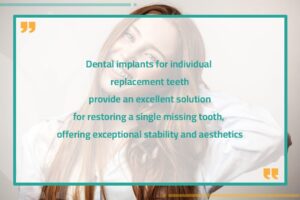Implant Supported Bridges
Implant Supported Bridges are a highly effective solution for replacing multiple missing teeth. Especially when the surrounding teeth are not strong enough to support a traditional bridge. By anchoring the bridge to dental implants, patients can enjoy improved stability, functionality, and aesthetics.
The process of getting an implant-supported bridge typically involves multiple visits to the dentist. During the initial consultation, the dentist will assess the patient’s oral health and create a personalized treatment plan. This may involve X-rays, impressions, and other diagnostic tests to ensure the implants and bridge will be a perfect fit.
Once the implants are surgically placed into the jawbone, a healing period is needed to allow the implants to fuse with the bone. This process, known as osseointegration, is crucial for the long-term success of the implant-supported bridge.
When the implants have been integrated with the jawbone, the custom-made bridge is attached to them, completing the restoration. The result is a natural-looking, durable bridge that restores the patient’s ability to eat, speak, and smile with confidence.
Implant-supported bridges are a revolutionary solution that provides outstanding support and stability. It makes them an ideal choice for many patients seeking to restore their smile and dental function.
When considering options for replacing missing teeth, another popular choice is an implant-retained denture. This type of denture is secured in place by dental implants, providing exceptional stability and support.
Implant Retained Denture
The process of obtaining an implant-retained denture begins with a thorough consultation with your dentist. During this visit, the dentist will evaluate your oral health and discuss the treatment plan with you. Diagnostic tests such as X-rays and impressions may be taken to ensure the precise fit of the dental implants and the denture.
Following the placement of the dental implants into the jawbone, a period of healing is necessary for the implants to integrate and fuse with the bone. This integration process is critical for the long-term success of the implant-retained denture, as it provides a strong foundation for the denture.
Once the dental implants have fully integrated with the jawbone, the custom-made denture is attached to them. The result is a secure and natural-looking denture that restores your ability to eat, speak, and smile comfortably.
Implant-retained dentures offer exceptional stability, comfort, and functionality, enhancing the quality of life for individuals seeking a reliable solution for missing teeth.
Screw in Teeth
Another innovative option for addressing missing teeth is the use of dental implants for securing individual replacement teeth. This method involves the placement of a small titanium screw into the jawbone, which serves as a strong and stable foundation for a custom-made artificial tooth.
The process of getting a dental implant for an individual replacement tooth begins with a comprehensive evaluation and treatment planning with your dentist. Diagnostic tests such as X-rays and impressions will be taken to ensure the precise positioning of the dental implant and the artificial tooth.
After the dental implant is surgically placed in the jawbone, a period of healing is necessary for the implant to integrate and bond with the bone. This integration process is essential for the long-term success and stability of the replacement tooth.
Once the implant has fully integrated, the custom-made replacement tooth is attached to it, effectively restoring the function and appearance of the missing tooth. This results in a natural-looking and durable replacement that allows for normal eating, speaking, and smiling.
Dental implants for individual replacement teeth provide an excellent solution for restoring a single missing tooth, offering exceptional stability and aesthetics.
Find the answers of FAQ on Arms Liposuction
Implant Supported Dentures Cost
When considering the cost of implant-supported dentures, it’s important to take into account the various factors that can influence the overall price. The cost of implant-supported dentures can vary based on the number of implants needed, the type of denture chosen, the materials used, and the specific requirements of each patient’s case.
The initial consultation with your dentist will involve discussing the cost of the procedure and the personalized treatment plan. It is important to understand that while implant-supported dentures may have a higher initial cost than traditional dentures, they offer superior stability, comfort, and functionality, making them a worthwhile investment in the long run.
Additionally, some dental insurance plans may provide coverage for implant-supported dentures, so it’s recommended to inquire about potential insurance benefits with your provider. Some dental practices may also offer financing options to help make the cost of implant-supported dentures more manageable.
It’s essential to remember that the benefits of implant-supported dentures, including improved oral health, aesthetics, and overall quality of life, can outweigh the initial investment. Ultimately, the cost of implant-supported dentures reflects the high quality and long-term value they provide for those seeking a reliable and durable solution for missing teeth.
Lower Dentures
When it comes to addressing the issue of lower dentures, many individuals experience challenges with the stability and comfort of traditional removable dentures. Lower dentures can be particularly troublesome as they tend to be less stable due to the movement of the tongue and the lack of adequate jawbone support.
Fortunately, implant-supported lower dentures offer a solution to these concerns. By anchoring the denture to dental implants, patients can experience significantly improved stability, comfort, and functionality. The dental implants provide a secure foundation for the lower denture, preventing slippage and allowing for a more natural feeling while eating, speaking, and smiling.
The process of obtaining implant-supported lower dentures begins with a comprehensive evaluation by your dentist. This assessment will determine the number and placement of dental implants needed to support the denture effectively. Diagnostic tests, such as X-rays and impressions, will be taken to ensure precise positioning and fit.
After the dental implants are surgically placed into the jawbone, a healing period is necessary to allow for osseointegration, the fusion of the implants with the bone. Once the integration is complete, the custom-made lower denture is attached to the implants, providing a secure and stable fit.
Lower Dentures Without Implants
When it comes to addressing the issue of lower dentures without implants. There are alternative options available to enhance stability and comfort.
One common solution for improving the stability of lower dentures is the use of denture adhesive. Denture adhesives are products that can be applied to the underside of the denture to improve its adherence to the gums. It minimizes movement during eating and speaking. While denture adhesives can provide some temporary relief. They may not offer the same level of stability and confidence as implant-supported lower dentures.
Another option to consider is a reline or adjustment of the lower denture. Over time, changes in the jawbone structure and gum tissue can affect the fit of the denture, leading to instability and discomfort. A dental professional can perform a reline or adjustment to ensure a more secure. It`s comfortable fit of the lower denture. However, it’s important to note that these adjustments may only provide a temporary solution. It may need to be repeated periodically as the jawbone continues to change.
For individuals experiencing significant challenges with traditional lower dentures. It may also be beneficial to explore alternative tooth replacement options with the guidance of a dental professional. Each patient’s case is unique, and a thorough evaluation by a dentist can help determine the most suitable solution for addressing the specific concerns related to lower dentures.
While implant-supported lower dentures offer exceptional stability and functionality. Individuals who are unable to pursue this option can still seek improvements in the comfort and fit of their lower dentures through alternative methods. It’s important to consult with a dental professional to explore the available options. Adding to that, determining the most suitable approach for enhancing the stability and comfort of lower dentures.
Read about 5 key information for Smart Lipo
Lower Denture with 2 Implants
Implant-supported lower dentures offer a revolutionary solution for individuals facing challenges with traditional removable lower dentures. By integrating dental implants into the jawbone, a secure foundation is created for the lower denture. Thus, it addresses issues of stability and comfort.
The process of obtaining implant-supported lower dentures typically involves the placement of two dental implants in the lower jaw. These implants serve as sturdy anchors for the denture. Therefore, effectively minimizing slippage and providing a more natural feeling while eating, speaking, and smiling.
The use of two implants for lower dentures has been found to significantly enhance stability and functionality. It offers a comfortable and reliable alternative to traditional removable dentures. This approach not only restores confidence in chewing and speaking but also contributes to overall oral health and well-being.
Individuals considering implant-supported lower dentures are encouraged to consult with their dentist to undergo a comprehensive evaluation and discuss personalized treatment plans. During the consultation at Natural Beauty Turkey, the dentist will assess the specific requirements for implant placement. In addition to the fabrication of the custom-made lower denture, ensuring a tailored approach to meet the patient’s unique needs.
With the advancement of dental implant technology, the option of two implants for lower dentures has become a widely recognized and successful method for overcoming the challenges associated with traditional removable dentures. The integration of dental implants not only provides stability and comfort. But also contributes to a natural and aesthetically pleasing outcome for individuals seeking a durable solution for their lower denture needs.
Implant Bridge
The Benefits of Implant Bridge
In addition to implant-supported lower dentures, another innovative solution for replacing missing teeth is the implant bridge. An implant bridge offers a fixed and durable alternative to traditional removable bridges. It provides significant advantages in terms of stability, functionality, and aesthetics.
How It Works?
An implant bridge involves the placement of dental implants to support a prosthetic bridge that replaces multiple missing teeth. The implants serve as secure anchors for the bridge, preventing movement and slippage while eating and speaking. This approach offers a more natural and comfortable feel compared to traditional removable bridges.
Enhanced Stability and Functionality
By integrating dental implants into the jawbone, an implant bridge provides exceptional stability and functionality. It eliminates the need for adhesives and uncomfortable clasps. It allows individuals to regain confidence in their ability to chew. Also, you can speak without concerns about the bridge shifting or loosening.
Aesthetically Pleasing Outcome
Implant bridges are designed to closely resemble natural teeth, resulting in an aesthetically pleasing outcome. The custom fabrication of the bridge ensures a seamless blend with the existing teeth. It`s creating a harmonious and natural-looking smile.
Consultation and Customization
Individuals interested in implant bridges are advised to schedule a consultation with a dental professional to discuss their specific needs and undergo a comprehensive evaluation. During this process, the dentist will assess the suitability of dental implants. He`ll determine the number of implants required, and develop a personalized treatment plan to achieve the desired outcome.
Conclusion
The implant bridge offers a transformative solution for individuals seeking a reliable and long-term option for replacing missing teeth. By combining the benefits of dental implants with a custom prosthetic bridge. This approach not only addresses functional concerns. But also enhances the overall appearance and confidence of individuals with missing teeth. If you are considering options for tooth replacement, exploring the potential of an implant bridge with a dental professional can open up new possibilities for improving your oral health and quality of life.






